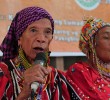A study on the means, motives and opportunity behind such killings points to the elements of the Armed Forces of the Philippines (AFP) and/or their agents like the Civilian Armed Force Geographical Unit (Cafgu) and death squads.
The AFP, being the biggest armed group in the country, has the means of launching such offensives on a nationwide scale. It has enough resources and manpower to undertake a systematic attack on the progressive movement.
Death squads are motorcycle-riding men wearing masks and armed with high caliber pistols or rifles. Karapatan records show that there were 41 killings that involved this kind of operation, and were implemented nationwide.
Pronouncements by the regime�s Cabinet Oversight Committee for Internal Security (COC-IS) reveal the motives behind the killings. Its members include General Eduardo Ermita, National Security Adviser Norberto Gonzales, Justice Secretary Raul Gonzalez, Defense Secretary Avelino Cruz, AFP Chief of Staff Gen. Generoso Senga, and PNP Director General Arturo Lomibao.
As early as 2004, Norberto Gonzales named the progressive party-list groups Bayan Muna, Anakpawis, Gabriela, Anak ng Bayan, Suara Bangsa Moro and Migrante as communist fronts.
In a Powerpoint presentation �Knowing the Enemy� released by the AFP in the first quarter of 2005, more legal organizations, including church groups and journalists� groups, were branded as communist fronts. In the book trilogy �Trinity of War�, the Northern Luzon Command (Nolcom) further identifies alleged front organizations of the Communist Party of the Philippines and the NPA.
The state security forces� motives for undertaking extrajudicial killings is summed up in its widely circulated view that progressive legal organizations and mere �communist fronts� and are thus enemies of the state.
In many incidents, state armed forces and agents also have the opportunity to carry out the �neutralization� of their targets. Neutralization is the euphemism used by the military for physical elimination of killing. Pieces of circumstantial evidence to the killings prove this.
Adelina Golloso, mother of Maylene and Raymund, saw how elements of the 2nd Infantry Battalion and the 902nd Infantry Brigade of the 9th Infantry Division of the Philippine Army fired at their house on May 7, 2004.
Reaching home from some errands, Adelina shouted at the soldiers to stop. She saw her daughter Maylene, 13 and her son Raymund, 6, lying on the ground, bathed in blood.
She asked for the soldiers� help but the latter just walked away. The next day, military officials claim the incident at Bgy. Recto was a legitimate encounter with the NPA.
Eyewitnesses testified before the court that the twin killing of Eden Marcellana and Eddie Gumanoy is the handiwork of then Col. Jovito Palparan Jr. Witnesses, who were abducted along with the two, point to the �Bonnet Gang,� a paramilitary group linked with the Philippine Army�s 204th Infantry Battalion of which Palparan was the commanding officer.
The cases of murder of Eden Marcellana, Eddie Gumanoy, Benjaline Hernandez and Edilberto �Choy� Napoles Jr. have been filed in the local courts. Napoles, Bayan Muna member in Mindoro Oriental was killed by the �Bonnet Gang� on May 28, 2002. There are witnesses and enough evidence that point to the elements of the military as perpetrators but justice has not been served. Their cases have been elevated by Karapatan to the United Nations Human Rights Committee.
Many received death threats from the military before they got killed.
Bayan Muna member Ricardo Uy, was killed on Nov. 18, 2005 at about 11 a.m. inside his own rice mill in Barangay Basud, Sorsogon City. Two Saturdays before Ding�s death, a radio program run by the Philippine Army in dzMS Sorsogon City, �Ugnayan sa Kapayapaan� (linking for peace), maliciously tagged him as an �emerging leader� of the NPA.
Another victim, Marcelino Fabula of Anakpawis-Pagsanjan in Laguna, was interrogated by a certain Lt. Andy Veneracion of Camp Lusiana. On Dec. 4, 2005, Fabula was shot dead by Jacinto Losano, a CAFGU member closely linked with Veneracion.
Before his death, Marcelino Beltran�s house was frequented by soldiers based in Tarlac. Ka Marcing, an eyewitness to the Hacienda Luisita Massacre, was killed on Dec. 8, 2004, days before he could have testified before the Senate.
Victor �Ka Ben� Concepcion, Anakpawis coordinator for Mexico, Pampanga and chair of provincial peasant organization, experienced the same. Before being killed on March 17, 2005 inside his home in Angeles City, Ka Ben noted increased military surveillance. He reported to his colleagues how suspected agents of the Northern Luzon Command (Nolcom) surrounded his home in Anao, Mexico.
Fact sheets, eyewitness accounts, direct and circumstantial evidence (as strong as the former) point to the elements of the AFP and their death squads as perpetrators.
Previous: Who exactly are the victims of extra-judicial killings?
Next: Who must account for these killings?










